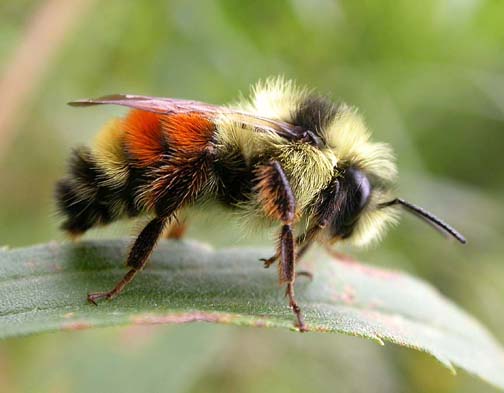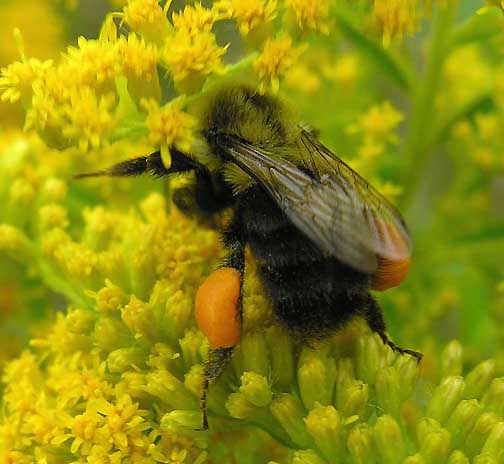May 11th, 2006
the bee’s knees

With cherry and pear trees now in flower here at the farm, I’ve been seeing plenty of Bumblebee activity over the past few days. For some time now, I’ve been trying to photograph as many Bumblebees as I can in order to get to know the various species a little better. It seems that many people are surprised to find that there is more than one kind of Bumblebee — those fuzzy, round-bodied, yellow and black bees that bump and buzz around through the flowers. In fact, there are quite a number of species that belong to the genus Bombus. I think there are something like 45 species of Bombus found in North America (but better not quote me on that as it could be a few more). As well, there are another half-dozen or so species belonging to the genus Psithyrus, a group of bees which do not collect pollen — well, more about them a little further on.
I’m chiefly interested in Bombus bees, or more specifically, those Bumblebees that collect pollen. When you really begin looking at them, you’ll soon find that there’s a great deal of variation in their size, body shape, wing shape, and coloration – as can be seen in the above photo of what I believe is B. ternarius, and the photo below, which is probably B. impatiens. There’s a lot of physical difference between females and males, with queens usually being considerably larger. And there’s also considerable difference in their temperament, with some being very docile, while others are — shall we say — a little on the testy side (definitely don’t push their buttons or you could be sorry). I’ve never been stung while photographing Bumblebees, but have been chased by a few large, predominantly yellow bees which I’m quite sure were probably B. fervidus, which has a reputation for being rather aggressive (“The Natural History of Bumblebees” by Carol A. Kearns and James D. Thomson – p59). Offhand, I can’t remember if I’ve got any good B. fervidus photos, but if not, there’s probably a good reason for the lack. (-:

Bombus bees may be distinguished from the above-mentioned Psithyrus bees by their anatomy (should you wish to get close enough to see). Bombus bees collect pollen and have hind legs which are formed in such a way that pollen can be packed into wide or concave surfaces which are usually surrounded by stiff hairs. This pollen collecting area of the leg is referred to as the corbicula. The above photo gives some idea of the shape of the leg if you examine the small bit of pollen that has been collected and is adhering to the left hind leg. When the legs are more fully loaded, the pollen will be quite conspicuous, as in the next photo. Bombus bees also have a fuzzy layer of hair on both the upper and lower sides of the abdomen. Psithyrus bees differ from Bombus as they do not collect pollen and, in fact, are “social parasites” of the Bombus bees. Psithyrus females kill a resident Bombus queen and deposit their own eggs in her colony. The Bombus workers then feed the usurper and her brood. As Psithyrus do not collect pollen, their hind legs do not have corbiculae. Their abdomens lack hair and have a thick, shiny cuticle which is usually visible if you’re close enough to take a look. This type of abdomen makes them better equipped when attacking and stinging the less armor-plated Bombus bees.

Identifying bees seems a rather difficult business (at least to me) – probably made all the more difficult by the fact that I don’t actually collect the bees, but try to do IDs based on photos. A lot of bee photos that I’ve seen in online collections or in book plates, are of dead bees. Their coloration is usually very poor and the specimens often so desiccated that it’s hard to make good comparisons. It would also probably be better if I examined bees “in hand”, but that’s not really possible unless I capture and chill bees in the refrigerator (something I’ve rarely done). However, I’ve recently found a pretty good online bee identification guide on the Discover Life website. It seems to work quite well for IDing bees from good photographs. I’ll try to post more on Bumblebees, and many other bees as well, as I begin shooting more photos this season.
Tags: Bumblebee, Bombus ternarius, Bombus impatiens, Bombus fervidus
May 11th, 2006 at 3:20 pm
What fantastic close-ups of these bees. I love the way they collect pollen on their hind legs. Such work. When I read about the Psithyrus bees, it reminded me of the brown-headed cowbird that has recently shown up at our feeder. I recall that they were here last year, and I wonder whose nest it’s going to leave its eggs in. What a strange evolutionary direction, to be a social parasite.
May 12th, 2006 at 1:49 am
RA – Yes, it sure does seem like a lot of work for the bees to collect pollen as they do. I’m always amazed at all of the work that they do. You’re quite right about the Psithyrus bees and the brown-headed cowbird. Odd how some species of creatures evolve in such a way that they exploit others.
May 12th, 2006 at 9:50 am
Both Églantine and I have been following bumblebees around off and on for nothing but frustration. We have yet to get even a fair photo. Not only that, I had not realized that there were more than one kine of bumblebee. Obviously there is much to learn yet. (Everytime I start to try to ID an insect I get frustrated with the number of species that look almost the same.)
May 12th, 2006 at 10:36 am
O.W. – Bumblebees are definitely difficult photographic subjects. The best time to get photos of them is early on a cool morning, especially in late summer. I’ve often found Bumblebees resting on the centers of flower blossoms. Apart from that, it just takes some practice. On certain flowers, they move around so much that it’s almost impossible to get good shots. On other flowers, they may spend quite a bit of time on a single blossom, allowing you time to snap off a few shots. And yes, it is a bit frustrating to try to ID many insects. I try to ID to species on some things, but just to genus or even not that far on certain insects or spiders. I’m learning a little more all of the time, so I often just stick a question mark on a photo and hope that later on, I’ll figure it out. Occasionally, I get one of those “Ah-Ha!” moments and can put a name on one of my mystery insects.
May 12th, 2006 at 10:58 am
All the pictures are great, as always, but the top pic is particularly fantastic. That flush of brilliant orange is amazing.
OK, now I’ll add bumblebees to the list :-) We have a nice cool morning right now, and several mints in flower.
May 12th, 2006 at 8:11 pm
Wayne — I’m particularly partial to the red-tailed bees and go a bit out of my way to photograph them whenever I see one around – mainly because they are less common. In my area, they’re far outnumbered by the black and yellow species. Lots of different things to add to our lists of things to observe! (-:
May 12th, 2006 at 11:41 pm
Very cool! I’ve been chasing bumble bees aroundthe yard lately, (kind of like the oj simpson chase…) and really haven’t managed the shots I’d like.
This one came out pretty well, not for ID purposes, but just cuz. :)
May 13th, 2006 at 11:18 am
RV – Thanks! I like your shot of the bee flying through the foliage! That’s actually how they look most of the time when you’re watching them as they’re so active. They don’t call them ‘busy bees’ for nothing! (-:
May 15th, 2006 at 4:08 pm
We had bumble bees at the house we lived in when my children were very little. One of my daughters used to point at the bumble bee and exclaim “Mommy! Bee BUMBLE!”
Your photographs are wonderful.
May 15th, 2006 at 9:06 pm
Leslie – That’s funny! When I was very young, I used to like to point at cows and horse when we were driving by fields, and say “horse” or “cow”. Apparently, I was wrong a lot of the time, so my parents would correct me with, “No, that’s a horse” or “No, that’s a cow.” Finally, I started calling everything that looked remotely like a horse or cow a “horsey-cow”… which covered all of the bases. (-:
September 30th, 2006 at 9:28 pm
I agree that trying to ID from the web is tough! I’m still having a hard time identifying this bee-mimic fly: http://casadegalletti.blogspot.com/2006/08/was-it-bee-or-fly.html but thanks to you I know it’s not a bee – totally wrong leg structure – which is what I suspected all along.